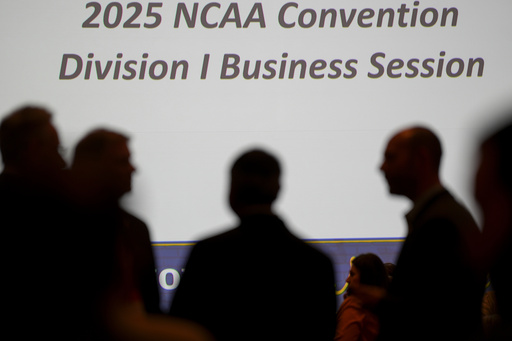NASHVILLE, Tenn. — Women’s basketball teams will now receive compensation for participating in the NCAA Tournament, a change that reflects a long-overdue step toward parity with the men’s tournaments. This new plan was unanimously approved at the NCAA convention on Wednesday and is poised to transform the financial landscape for women’s college basketball. The decision received enthusiastic applause from attendees and signals a move towards greater recognition and investment in women’s sports.
This initiative follows the prior unanimous support from the Division I Board of Governors back in August, as NCAA President Charlie Baker acknowledged the efforts of those who have laid the foundation for women’s basketball. Baker expressed hope that upcoming generations will continue to build on the achievements made today, emphasizing the necessity for ongoing investment to further develop the sport. “I hope that someday down the road, we all will have someone say about us that they sit on the shoulders of the work that we did,” stated Baker.
Dawn Staley, head coach of the South Carolina Gamecocks, which recently clinched their third national championship, reacted positively to the decision. Her response was simply “YES!”, reflecting her appreciation for efforts aimed at raising the profile of women’s basketball. Staley commended the work done by the Kaplan Hecker and Fink law firm for highlighting that the absence of performance units had previously hindered women’s basketball from realizing its potential, particularly given the sport’s rising viewership.
The newly established performance units represent revenue generated from participation in the tournament and will start distributing funds to women’s teams during this year’s competition, marking its 43rd year. A team reaching the Final Four could earn about $1.26 million for its conference over the next three years. The first year alone is expected to allocate $15 million to participating teams, which equates to 26% of the women’s basketball media revenue deal. By 2028, this figure is expected to increase to $25 million or 41% of the revenue—matching the initial distribution percentage received by men’s teams when their performance units program was first launched.
While teams in this March’s NCAA Tournament will not see direct payments until all necessary data is compiled, Courtney Banghart, North Carolina’s head coach and president of the Women’s Basketball Coaches Association, hailed this development as a recognition of the substantial investments made by athletic departments in women’s basketball. “The long-awaited, hard-fought for, and well-earned day is here,” Banghart said, expressing gratitude for the concerted efforts to elevate women’s basketball.
UConn guard Paige Bueckers shared similar sentiments, highlighting the significance of this milestone for the growth and visibility of women’s sports. “Just for women to capitalize on what we brought to the sport… we are extremely grateful,” she said.
The proposal that emerged included two separate votes, with the initial vote about the payments receiving only one dissenting response while the overall establishment of the women’s fund garnered unanimous support from all 292 voting members. The framework of the women’s March Madness plan resembles that of the men’s basketball unit program, where each of the 32 conferences securing an automatic tournament bid will gain units, along with additional units for at-large bids within the 68-team field.
The structure rewards longer tournament runs, leading to increased unit allocations for conferences, which decide how to distribute these funds among their members. Each unit was approximately valued at $2 million for the upcoming men’s tournament. As of now, men’s basketball teams enjoy 24% of a media rights deal worth $8.8 billion over an eight-year period, whereas the women’s tournament’s media rights are valued significantly higher at $65 million per tournament in a recent agreement with ESPN.
The NCAA traditionally shares March Madness revenues with its member schools, creating a financial structure that benefits over 300 Division I programs. This revenue is typically reinvested into athletic programs, funding everything from athlete scholarships and coaching salaries to facility upgrades and athletic amenities. Julie Roe Lach, the Horizon League commissioner, articulated that the newly established fund is a monumental progression for women’s basketball and women’s sports overall, emphasizing their shared commitment to gender equity. She noted that the Horizon League already has frameworks to incentivize programs based on their performance and schedule strength.
Geno Auriemma, another influential figure in women’s basketball due to his eleven national championships, remarked on the financial implications of this decision, which capitalizes on existing broadcast rights and corporate sponsorships. Historically, leagues like the Big East have prioritized sharing revenue, recognizing how pivotal NCAA financial allocations are for smaller athletic departments.
The women’s tournament recently reported record attendance and viewership, underscoring its growing popularity. For instance, last year’s championship game attracted 18.7 million viewers, marking the highest ratings for a basketball broadcast in five years, and surpassing audience numbers for the men’s championship by nearly 3 million.
In additional developments, the Division I recently approved a championship for women’s wrestling, with deliberations also happening in Divisions II and III. Furthermore, SEC Commissioner Greg Sankey stated that any modifications to the College Football Playoff structure would require unanimous consensus, while discussions are ongoing regarding new eligibility rules that could grant athletes five years to compete within a five-year window.




